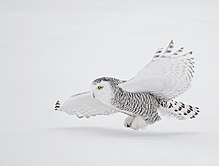Snow camouflage
Among animals, variable snow camouflage is a type of seasonal polyphenism with a distinct winter plumage or pelage.
[1]The white protective coloration of arctic animals was noted by an early student of camouflage, the naturalist Alfred Russel Wallace, in his 1889 book Darwinism; he listed the polar bear, the American polar hare, the snowy owl and the gyr falcon as remaining white all year, while the arctic fox, arctic hare, ermine and ptarmigan change their colour, and observed "the obvious explanation", that it was for concealment, at a time when Darwinism was at a low ebb.
[2] Later zoologists such as Hugh B. Cott have echoed his observations, adding that other animals of the Arctic such as musk ox, moose, reindeer, wolverine and raven never become white "even in the coldest parts of their range".
[9] The effects of climate change can lead to a mismatch between the seasonal coat coloration of arctic animals such as snowshoe hares with the increasingly snow-free landscape.
Uniforms were largely of a single colour, such as the British khaki;[11] but snow camouflage clothes came into use in some armies as the war progressed.
[14] Several armies in the Second World War in Northern European countries preferred separate winter uniforms rather than oversuits.
The Waffen-SS went a step further, developing reversible uniforms with separate schemes for summer and autumn, as well as white winter oversuits.
American troops in Europe in the winter of 1944 to 1945 improvised snow capes and helmet covers from white cloth such as bed linen.




